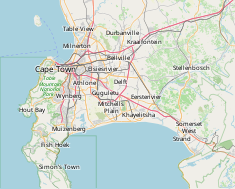Our website is made possible by displaying online advertisements to our visitors.
Please consider supporting us by disabling your ad blocker.
Groote Schuur
| Groote Schuur | |
|---|---|
 | |
| Location | Rondebosch, Cape Town, South Africa. |
| Coordinates | 33°57′49.61″S 18°27′50.40″E / 33.9637806°S 18.4640000°E |
| Built | 18th century |
| Architect | Sir Herbert Baker (19th century refurbishment) |
| Architectural style(s) | Cape Dutch |


Groote Schuur (pronounced [ˈɣroːtə ˈsxyːr]; Dutch for 'big shed') is an estate in Cape Town, South Africa. In 1657, the estate was owned by the Dutch East India Company which used it partly as a granary. Later, the farm and farmhouse was sold into private hands. Groote Schuur was later acquired by William De Smidt, and remained in the family's possession until it was sold by Abraham De Smidt, Surveyor General of the Cape Colony, in 1878, and was bought by Hester Anna van der Byl of the prominent Van Der Byl / Coetsee family.[1] In 1891 Cecil Rhodes leased it from her. He later bought it from her in 1893 for £60 000, and had it converted and refurbished by the architect Sir Herbert Baker. The Cape Dutch building, located in Rondebosch, on the slopes of Devil's Peak, the outlying shoulder of Table Mountain, was originally part of the Dutch East India Company's granary constructed in the seventeenth century.
Little of the original house remained after a fire in 1896. The traditional thatched roof was replaced by sturdier Welsh slates. Rhodes gave no strict instructions as to what he wanted from Baker. Rhodes abhorred any mechanically made items (such as hinges for windows) in the house and set out to remove them and have them replaced with brass and bronze items that would be cast. Baker replaced the front of the house, added a long stoep in the back and constructed a new wing. The wing contained a billiard room and master bedroom above on the second floor that contained a large bay window overlooking Devil's Peak. He also added a grand hall with a massive fireplace.[2] The house is home to 4 Flemish 17th century tapestries, depicting America, Africa, Europe and Victory. [3]
Sir Herbert Baker also played a significant role in the furnishing of the house. After initially furnishing with modern furniture from London, Rhodes, influenced by Baker, began a shift from the modern to more traditional Cape furniture. This would mark the beginning of Cecil Rhodes’ collection of colonial furnishings.[2]
The gardens of the house were as Rhodes demanded 'masses of colour'. Surrounding the house was a mass of roses, hydrangeas, cannas, bougainvilleas and fuchsias. Farther away from the house on the slopes of Devil's Peak, Rhodes kept antelopes, zebra, eland, wildebeest and ostriches.[4]
Rhodes was always a generous host while at Groote Schuur. He used the residence as much as a business and political headquarters as a home. His life at the time was one of dinner parties and meetings on the stoep, where he would be joined by as many as fifty people.[5]
Previous Page Next Page



